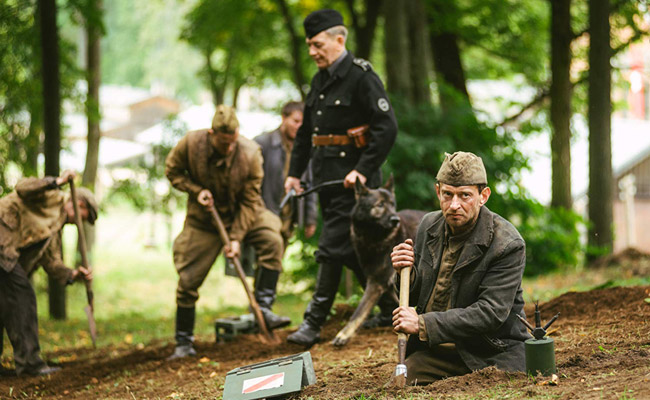
Samuel Goldwyn Films
In 1943, 300 of 600 prisoners in the death camp of Sobibor (in occupied Poland) attempted to escape the camp — most were killed during and after the attempt, but some survived. I remember watching a made-for-TV movie called Escape from Sobibor (released in 1987) one day when I was in school. I have vague memories of it, but after rewatching some of it to prepare for this review, I noticed it’s oddly bloodless despite the horrible images.
Sobibor is a Russian movie from director Konstantin Khabensky, who also plays one of the lead characters, Alexander Pechersky, a former Soviet officer who helped orchestrate the escape. The movie begins with the uneasy, knowing shots of a train entering a camp, where musicians play and Nazi officers offer false blandishments and fake politeness as they divide old men and women, children, and other ‘non-useful’ people from the potential temporarily useful ones — the seamstresses, the jewelers, the leatherworkers, etc.
The movie focuses on a few people: a husband separated from his wife as we then follow her into the gas chambers, where the movie explicitly shows the horrors. It’s debatable whether or not this is a good artistic choice, because although it is honest in the torture and crimes against humanity, you do wonder if there is something immoral and exploitative about it. I’m not really sure about it myself, but it is important to consider before watching or not.
Another person followed is young Shlomo (Ivan Zlobin), a teenager who is separated from his family and begins to develop a desire for vengeance, and thus can easily connect with Pechersky, who not only longs to escape, but wants to kill as many SS as they can in the process. The world of hell is painted well after the first initial troubling start, a dark, bloody horror show.
Much attention is paid to accurate languages, although some of the dubbing of the Yiddish dialog doesn’t always sync up correctly with their lips. Among the cast is Mariya Kozhevnikova as Selma, a real life person and escapee, and romantically connected with another prisoner at the camp. Also present (oddly enough) is Christopher Lambert as commandant Karl Frenzel, playing this real life conflicted monster with a weird mix of hypocrisy and villainy.
His acting choices are odd, often constipated, and ultimately he often ends up being distracting and out of place. Other actors as the miscellaneous and interchangeable sociopathic guards certainly feel believable, in an uncomfortable, difficult to watch way. The uprising, when it comes, is almost rushed and jammed with dramatic moments, but ultimately it does feel like it works.
A lot of specific directorial choices are made that are often evocative and unusual, lighting and shot composition choices that juxtapose the real life terror with the attempts of creating an audiovisual canvas. The movie does have moments of dark (literally), where it is hard to see what is happening, and sometimes the pacing drags, but it does feel like an engaging and slightly satisfying story of vengeance and escape in the place of hopelessness. I can’t begin the parse the politics of the movie from a Russian movie perspective, but it has surprising empathy for its victims. A hard movie to watch, but maybe some high schooler will see it one day in class.
Sobibor has a run time of 1 hour 50 minutes and is unrated.
